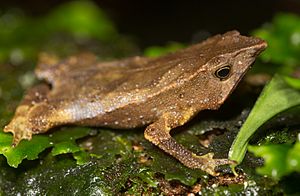Rhinella festae facts for kids
Quick facts for kids Rhinella festae |
|
|---|---|
 |
|
| Conservation status | |
| Scientific classification | |
| Synonyms | |
|
Rhinella festae is a special kind of toad found in the wild. It belongs to a group of toads called the Bufonidae family. This small amphibian lives in specific parts of South America, mainly in the countries of Ecuador and Peru.
These toads like to live in warm, wet places. Their natural habitats include tropical lowland forests where it rains a lot. They also live in moist montane forests, which are forests found on the sides of mountains. Sadly, Rhinella festae is currently facing threats, mostly because its home is disappearing.
Contents
What is Rhinella festae?
Rhinella festae is a species of toad, first described in 1904 by a scientist named Peracca. Toads are amphibians, which means they can live both on land and in water. They are known for their bumpy skin and short legs. This specific toad is part of the Rhinella genus, which includes many different types of toads found across Central and South America.
How are toads different from frogs?
While often confused, toads and frogs have some key differences. Toads, like Rhinella festae, usually have dry, warty skin. They tend to live more on land, though they still need moisture. Frogs, on the other hand, often have smooth, moist skin and prefer to stay closer to water. Toads also typically have shorter legs and are not as good at jumping as frogs.
Where Does Rhinella festae Live?
This unique toad is found only in two countries: Ecuador and Peru. These areas are in South America and are known for their rich biodiversity. The specific places where Rhinella festae lives are usually warm and have a lot of rainfall.
Understanding its habitat
Rhinella festae needs very particular environments to survive.
- Tropical Moist Lowland Forests: These are dense forests found in low-lying areas. They get a lot of rain and have many different plants and animals. The warm, humid conditions are perfect for amphibians.
- Tropical Moist Montane Forests: These forests are found on the slopes of mountains. They are also very wet and often covered in mist or clouds. The elevation can make these areas cooler than lowland forests, but they still provide the damp conditions the toad needs.
Why is Rhinella festae Important?
Every species, including Rhinella festae, plays a role in its ecosystem. Toads often help control insect populations, as they eat many different kinds of insects. They are also a food source for other animals, like snakes and birds. This makes them an important part of the food web in their forest homes.
What threatens this toad?
The biggest threat to Rhinella festae is habitat loss. This means that the places where these toads live are being destroyed or changed.
- Deforestation: Forests are cut down for farming, logging, or building. This removes the trees and plants that the toads rely on for shelter and food.
- Human Expansion: As human populations grow, more land is needed for homes and cities. This often leads to natural areas being cleared.
- Climate Change: Changes in weather patterns, like less rain or more extreme temperatures, can also make habitats unsuitable for the toads.
When their homes disappear, Rhinella festae toads have fewer places to live, find food, or reproduce. This makes it harder for them to survive and can lead to their numbers decreasing. Protecting their forest homes is very important for the future of this species.
See also
 In Spanish: Sapo del Valle de Santiago para niños
In Spanish: Sapo del Valle de Santiago para niños


